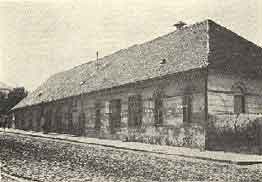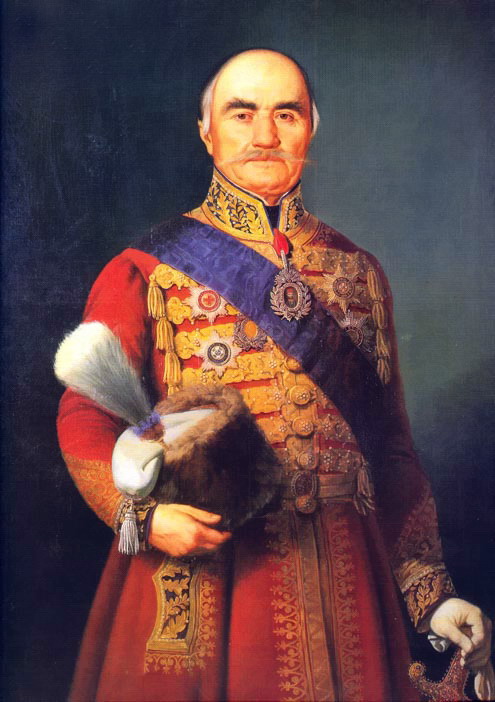|
Cabinet Of Miloš Vučević
The cabinet of Miloš Vučević was formed on 2 May 2024, following the latter's election as Prime Minister of Serbia by the National Assembly on the same day. It succeeded the third cabinet of Ana Brnabić and was the incumbent government of Serbia from 2 May 2024 to 16 April 2025. The Serbian Progressive Party (SNS) came to power in 2012. After the 2023 parliamentary election, Aleksandar Vučić, the president of Serbia, gave Vučević the mandate to form a government. The cabinet is composed of members of SNS, Socialist Party of Serbia (SPS), Democratic Alliance of Croats in Vojvodina (DSHV), Party of United Pensioners of Serbia (PUPS), Social Democratic Party of Serbia (SDPS), and Justice and Reconciliation Party (SPP), Serbian Party Oathkeepers (SSZ), Movement of Socialists (PS), and Serbian People's Party (SNP). With 32 ministers in total, it has the largest amount of ministers of any post- Milošević government. On 28 January 2025, Vučević resigned after mass prote ... [...More Info...] [...Related Items...] OR: [Wikipedia] [Google] [Baidu] |
Government Of Serbia
The government of Serbia ( sr-cyrl, Влада Србије, Vlada Srbije), formally the Government of the Republic of Serbia ( sr-cyrl, Влада Републике Србије, Vlada Republike Srbije), commonly abbreviated to Serbian Government ( sr-cyrl, Српска Влада, Srpska Vlada), is the executive branch of government in Serbia. The affairs of government are decided by the Cabinet of Ministers, which is led by the prime minister. The government is housed in the Government Building in Belgrade. Jurisdiction According to the Constitution of Serbia, the Government: * Determines and guides policy * Executes laws and other general acts of the National Assembly * Adopts regulations and other general acts for the purpose of enforcing laws * Proposes to the National Assembly the laws and other general acts and gives an opinion on them when submitted by another proposer * Directs and coordinates the work of public administration bodies and supervises their work * Perf ... [...More Info...] [...Related Items...] OR: [Wikipedia] [Google] [Baidu] |
Coalition Government
A coalition government, or coalition cabinet, is a government by political parties that enter into a power-sharing arrangement of the executive. Coalition governments usually occur when no single party has achieved an absolute majority after an election. A party not having majority is common under proportional representation, but not in nations with majoritarian electoral systems. There are different forms of coalition governments, minority coalitions and surplus majority coalition governments. A surplus majority coalition government controls more than the absolute majority of seats in parliament necessary to have a majority in the government, whereas minority coalition governments do not hold the majority of legislative seats. A coalition government may also be created in a time of national difficulty or crisis (for example, during wartime or economic crisis) to give a government the high degree of perceived political legitimacy or collective identity, it can also play a ro ... [...More Info...] [...Related Items...] OR: [Wikipedia] [Google] [Baidu] |
Novi Sad Railway Station Canopy Collapse
On 1 November 2024, the concrete canopy of the main railway station in Novi Sad, Serbia, collapsed onto the busy pavement below, killing 16 people and severely injuring one more. The station building was constructed in 1964, and was renovated from 2021 to mid-2024 with support from China's Belt and Road Initiative. The cause of the collapse is still under investigation. The collapse spawned a series of mass protests in Novi Sad, which then spread throughout Serbia, fueled by dissatisfaction with other issues including government corruption and media censorship. Background Station building The railway station was constructed in 1964. The building was structurally advanced for its period, bold, and relatively unusual. The roof, made from concrete slabs, is corrugated for rigidity and cantilevers over the main entrance. A suspended structure was affixed to this extending portion of the roof using steel tension elements. This structure mainly consisted of massive reinforced co ... [...More Info...] [...Related Items...] OR: [Wikipedia] [Google] [Baidu] |
Slobodan Milošević
Slobodan Milošević ( sr-Cyrl, Слободан Милошевић, ; 20 August 1941 – 11 March 2006) was a Yugoslav and Serbian politician who was the President of Serbia between 1989 and 1997 and President of the Federal Republic of Yugoslavia from 1997 until Overthrow of Slobodan Milošević, his оverthrow in 2000. Milošević played a major role in the Yugoslav Wars and became the first sitting head of state charged with war crimes. Born in Požarevac, he studied law at the University of Belgrade Faculty of Law during which he joined the League of Socialist Youth of Yugoslavia. From the 1960s, he was advisor to the mayor of Belgrade, and in the 1970s he was a chairman of large companies as the protégé of Serbian leader Ivan Stambolić. Milošević was a high-ranking member of the League of Communists of Serbia (SKS) during the 1980s; he 8th Session of the Central Committee of the League of Communists of Serbia, came to power in 1987 after he ousted opponents, includin ... [...More Info...] [...Related Items...] OR: [Wikipedia] [Google] [Baidu] |
2012 Serbian Parliamentary Election
Parliamentary elections were held in Serbia on 6 May 2012 to elect members of the National Assembly. The elections were held simultaneously with provincial, local, and presidential elections. Background The 2008 parliamentary elections resulted in the formation of a new pro-European government on 7 July 2008, with the necessary parliamentary votes coming from President Boris Tadić's For a European Serbia list, and the coalition of the Socialist Party of Serbia, the Party of United Pensioners of Serbia and United Serbia (the SPS-PUPS-JS coalition), plus six out of the seven minorities representatives. The new government elected Mirko Cvetković (endorsed by the Democratic Party) as Prime Minister. The opposition, the Serbian Radical Party (SRS), had a split after the elections. The Serbian Progressive Party (SNS) party broke off and is headed by Tomislav Nikolić and Aleksandar Vučić, both of whom were major figures in the SRS before the establishment of the SNS in late ... [...More Info...] [...Related Items...] OR: [Wikipedia] [Google] [Baidu] |
Government Of Serbia
The government of Serbia ( sr-cyrl, Влада Србије, Vlada Srbije), formally the Government of the Republic of Serbia ( sr-cyrl, Влада Републике Србије, Vlada Republike Srbije), commonly abbreviated to Serbian Government ( sr-cyrl, Српска Влада, Srpska Vlada), is the executive branch of government in Serbia. The affairs of government are decided by the Cabinet of Ministers, which is led by the prime minister. The government is housed in the Government Building in Belgrade. Jurisdiction According to the Constitution of Serbia, the Government: * Determines and guides policy * Executes laws and other general acts of the National Assembly * Adopts regulations and other general acts for the purpose of enforcing laws * Proposes to the National Assembly the laws and other general acts and gives an opinion on them when submitted by another proposer * Directs and coordinates the work of public administration bodies and supervises their work * Perf ... [...More Info...] [...Related Items...] OR: [Wikipedia] [Google] [Baidu] |
Third Cabinet Of Ana Brnabić
The third cabinet of Ana Brnabić was formed on 26 October 2022, following the latter's election as Prime Minister of Serbia by the National Assembly on the same day. It succeeded the second cabinet of Ana Brnabić. The Serbian Progressive Party (SNS) came to power in 2012. Brnabić was appointed prime minister by Aleksandar Vučić, the president of Serbia, in June 2017 and was elected shortly afterwards by the National Assembly. Initially an independent politician, she joined SNS in 2019; she was re-elected after the 2020 Serbian parliamentary election. After the snap 2022 parliamentary election, Vučić gave Brnabić another mandate to form a government and stated that she would serve for two years, instead of a regular four-year mandate. With the dissolution of the National Assembly on 1 November 2023, Brnabić's cabinet entered in acting capacity. As first deputy prime minister, Dačić took over the capacity of acting prime minister following Brnabić's election as presid ... [...More Info...] [...Related Items...] OR: [Wikipedia] [Google] [Baidu] |
National Assembly (Serbia)
The National Assembly ( sr-Cyrl-Latn, Народна скупштина, Narodna skupština, ), fully the National Assembly of the Republic of Serbia (), is the unicameral legislature of Serbia. The assembly is composed of 250 deputies who are proportionally elected to four-year terms by secret ballot. The assembly elects a president (speaker) who presides over the sessions. Wikisource: Constitution of Serbia The National Assembly exercises supreme legislative power. It adopts and amends the Constitution, elects Government, appoints the Governor of the National Bank of Serbia and other state officials. All decisions are made by majority vote of deputies at the session at which a majority of deputies are present, except for amending the Constitution, when a two-thirds majority is needed.National Assembly of SerbiaInformer (This text is in the public domain as the official material of the Republic of Serbia state body or a body performing public functions, under the terms of ... [...More Info...] [...Related Items...] OR: [Wikipedia] [Google] [Baidu] |
Prime Minister Of Serbia
The prime minister of Serbia ( sr-Cyrl, премијер Србије, premijer Srbije; feminine gender, feminine: премијерка/premijerka), officially the president of the Government of the Republic of Serbia ( sr-Cyrl, председник Владе Републике Србије, predsednik Vlade Republike Srbije; feminine: председница/predsednica) is the head of the government of Serbia. The role of the prime minister is to direct the work of the government, and submits to the National Assembly (Serbia), National Assembly the Government policy statement, government's program, including a list of proposed Minister (government), ministers. The resignation of the prime minister results in the dismissal of the government. The first officeholder was Matija Nenadović, who became prime minister on 27 August 1805. The current prime minister, Đuro Macut was nominated by the President of Serbia, president of the Republic, Aleksandar Vučić, and elected and appoi ... [...More Info...] [...Related Items...] OR: [Wikipedia] [Google] [Baidu] |
Cabinet Of Đuro Macut
The cabinet of Đuro Macut was formed on 16 April 2025, following the latter's election as Prime Minister of Serbia by the National Assembly (Serbia), National Assembly on the same day. It succeeded the cabinet of Miloš Vučević. The Serbian Progressive Party (SNS) came to power in 2012 Serbian parliamentary election, 2012. After the 2023 Serbian parliamentary election, Aleksandar Vučić, the president of Serbia, gave Miloš Vučević the mandate to form a government. He was elected in May 2024, but resigned amidst 2024–present Serbian anti-corruption protests, anti-corruption protests in January 2025. After the acknowledgment of his resignation by the National Assembly in March, negotiations were held to form a new government. Vučić gave Macut the mandate to form a government in early April. The cabinet is composed of members of SNS, Socialist Party of Serbia, Party of United Pensioners of Serbia, Social Democratic Party of Serbia, Serbian Party Oathkeepers, Serbian Peopl ... [...More Info...] [...Related Items...] OR: [Wikipedia] [Google] [Baidu] |
Third Cabinet Of Ana Brnabić
The third cabinet of Ana Brnabić was formed on 26 October 2022, following the latter's election as Prime Minister of Serbia by the National Assembly on the same day. It succeeded the second cabinet of Ana Brnabić. The Serbian Progressive Party (SNS) came to power in 2012. Brnabić was appointed prime minister by Aleksandar Vučić, the president of Serbia, in June 2017 and was elected shortly afterwards by the National Assembly. Initially an independent politician, she joined SNS in 2019; she was re-elected after the 2020 Serbian parliamentary election. After the snap 2022 parliamentary election, Vučić gave Brnabić another mandate to form a government and stated that she would serve for two years, instead of a regular four-year mandate. With the dissolution of the National Assembly on 1 November 2023, Brnabić's cabinet entered in acting capacity. As first deputy prime minister, Dačić took over the capacity of acting prime minister following Brnabić's election as presid ... [...More Info...] [...Related Items...] OR: [Wikipedia] [Google] [Baidu] |




